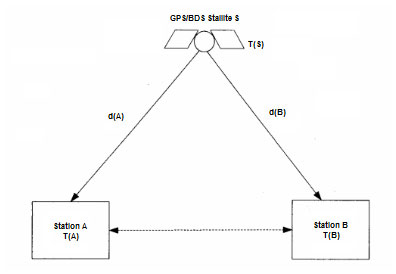Apply in scenarios of authentication, network devices, operators, power system
Overview
Common view means two observers at two different locations observe the same GPS/BDS satellite at the same time. GPS/BDS common-view method is one of the main time comparison methods for long distance on earth so far. It is a system firstly used to make the time comparison between the atomic oscillators in international timing labs in 1983. With this method, the uncertainty of time transfer can reduce to very small value, may be as low as 3-5ns. Therefore, it can be used by the users who need time service accuracy as good as nanoseconds level in the field of aerospace and missile, and those who need to take ultra-high precision time/frequency synchronization measurements in 5G networks.
Basic Principle
Here is the basic principle of GPS/BDS common-view method: Station A and B, which are to perform time transfer, receive a time signal from a GPS/BDS satellite S simultaneously. Let the reception times of the stations be T(A) and T(B); the propagation delay from station A and the satellite S is d(A), and the propagation delay from station B and the satellite S is d(B); △TAS is the time difference between the station A and the satellite S, △TBS is the time difference between the station B and the satellite S, thus △TAS and △TBS can be expressed as follows respectively:
△TAS=T(A)-T(S)- d(A) (1)
△TBS=T(B)-T(S)- d(B) (2)
By calculating the difference between formulas (1) and (2), time transfer can be performed using the GPS/BDS signals as an intermediary.
△TAB=△TAS-TBS-=(T(A)-T(B))-(d(A)-d(B)) (3)
As described above, the GPS/BDS common-view method cancels out satellite clock error and most of the propagation delay, and performs highly precise time transfer by ensuring that the stations that are to perform time transfer receive the signal from a single satellite simultaneously.
